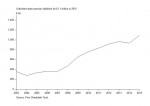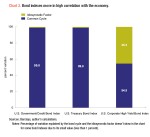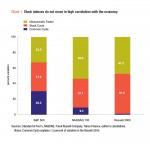Why Can’t Americans Save?
The outlook is rather grim. In the key metrics of financial wellness, including short-term emergency savings, investment, and indebtedness, many Americans fall short. We’ll take a closer look at why so many Americans aren’t achieving these financial milestones.
The reasons fall into two categories: financial constraints and behavior. Financial constraints simply mean that an individual or household cannot afford to adequately save for the short term, invest for the long term, and pay off existing debt. Notably, as many as half of all Americans, including some who are considered middle class, cannot afford to save or invest significant amounts while living even a modest lifestyle. But data also demonstrate that many Americans who are not financially constrained still do not meet the basic standards of financial wellness. This outcome may reflect individual preferences about risk and current versus future consumption, or it could reflect some of the systematic biases in decision making identified in recent years by behavioral economics.
We’ll examine some important elements of financial wellness: short-term savings, longer term investment, and debt. What are the reasons many Americans simply cannot afford to meet the criteria set forth for financial wellness? Finally, we will consider why those who can afford to set aside the money for financial wellness still do not do so.
Common elements of financial wellness
Saving Short-term, or liquid, savings can protect people from financial shocks, which are defined as any unexpected expenses or loss of income for which the household did not plan in ordinary budgeting. For example, a car may need repair or an injury might result in a significant leave from work. The necessity for such an emergency savings fund is underscored by a Pew Research Center survey, which found that 60 percent of households experienced just such a financial shock during the past year, with a median cost of $2,000. There is no single target for emergency savings agreed on by experts, but two, three, and six months of one’s income held in short-term savings are all commonly discussed goals. Americans often do not meet them. People in the lower half of the income distribution can, at the median, replace only one to two weeks of income from savings. But this lack of emergency savings is not limited to those struggling to get by. Even the median saver in the top income quartile ($85,000 and up) has only 40 days of income in liquid savings.
Investing Investing, or long-term saving for retirement (or items like a new home, for younger households) is next on the list of signs of financial wellness. Once again, American households invest far less than experts would like. One survey reported that 60 percent of the bottom half of earners were not involved in any retirement or investment plan. Once again, it is not only the poor who do not invest enough. A 2013 study by the Employee Benefit Research institute found that only 38 percent of workers aged 25 to 34 participated in an employer-based retirement plan. For workers aged 21 to 24, the number was under 20 percent.
Debt Perhaps the most obvious problem plaguing Americans’ financial wellness is debt. In 2015, the average credit-card debt for U.S. households was a staggering $5,883 (www.nerdwallet.com/blog/credit-card-data/average-credit-card-debt-household/). Student-loan debt is also notorious for harming households’ financial security. In 2015, the average holder of student-loan debt owed $30,100 (http://ticas.org/posd/map-state-data). Since debt often carries a higher interest rate than investments or savings accounts, it is generally prudent to pay it off before saving and investing. As we will show in budget simulations, even a few thousand dollars of debt makes following the other rules for financial wellness more difficult for many Americans.
Financial constraints on saving and investing
Affordability, or financial constraints, impede many Americans’ ability to meet the common standards of financial wellness. I ran a set of basic budget simulations to get an idea of how large that group is. I started by looking at how much income the average American has left after paying for basic expenses such as food and shelter, taxes, and health care. Households can choose how to use the rest of their money—for immediate consumption or savings and investment. But a key first question is how many Americans actually cannot afford the saving and investing goals discussed here. I based my calculations on single Americans. For households with children, it is likely that these common saving and investing goals would be more difficult to meet.
Case 1
Let’s start with a 30-year-old making the median income of $35,613 for that age (2016 Census, Current Population Survey). Chart 1 shows a basic budget simulation. This person pays federal and state income taxes totaling $558 (I used the Massachusetts rate of 5.1 percent for all state simulations). I then subtracted the basic cost of living using data from the Economic Policy Institute (www.epi.org/resources/budget/). It includes housing, food, transportation, health care, and a miscellaneous category. The EPI estimates this figure as $23,088 for 2015. Of course, this is an average figure that may differ widely—by where you live, for example. It is also worth emphasizing that this amount covers necessities: food, but not meals out; transportation, but not vacations.
After subtracting the cost of essentials, I set aside money in the budget for achieving financial wellness goals. I then considered how much “pocket” or “lifestyle” money would be left over. While these calculations cover the basics, a workable budget for a middle-class individual must also include at least some allowance for entertainment, travel, or buying new products.
One commonly discussed goal is that 20 percent of income should go to areas related to financial wellness (www.learnvest.com/knowledge-center/your-ultimate-budget-guideline-the-502030-rule/). I called this “savings/investment” and set it at 20 percent of after-tax income. Chart 1 demonstrates that this is not realistic for the median 30-year-old earner. It would leave only $4 a month in lifestyle money—essentially zero.
Case 2
Chart 2 demonstrates a more realistic path for the median 30-year-old earner: saving or investing 10 percent of income rather than 20 percent. In this case, $245 a month is left in lifestyle money. This suggests a potentially workable plan, though only 10 percent going to financial wellness goals is not ideal. For example, it would take 2.5 years at that rate to build an emergency savings fund equaling the recommended three months of salary. And the individual would ideally begin investing at the same time. Still, this scenario would result in attainable goals in a finite time frame.
Cases 3 and 4
Charts 3 and 4 show that middle-class Americans are hardly able to fit both lifestyle and financial wellness into their budgets. Chart 3 considers a single American earning $31,500 (in the 42nd percentile of income and within the middle class, as defined in our recent AIER research brief, www.aier.org/research/measuring-middle-class). In this case, the 10 percent rule that worked in Case 2 would no longer leave any room for lifestyle spending beyond necessities.
Chart 4 shows just how easily debt can knock people off the path to financial wellness. If you give our sample individual the average credit-card debt of $5,883 and assume they make monthly payments to pay off the card in 10 years, adhering even to the lower 10 percent savings rule becomes next to impossible. Individuals paying the average student-loan debt would end up with a similar result.
These calculations underscore that financial wellness is not a choice for many Americans. It is something they cannot afford even with a modest lifestyle. Furthermore, this lack of affordability is not limited to the poor. It affects both lower middle-class workers and those in the middle class who carry debt. These Americans must either lower their goals or raise their income in order to have the choice to set aside resources for financial wellness.
Behavioral factors impede saving and investing
While financial constraints explain much of why Americans may not be meeting financial-wellness standards, it’s also informative to look at the flipside of the numbers above. Almost half of Americans can afford to invest and hold adequate liquid savings. Do they? That does not appear to be the case. The median saver among those earning $85,000 is still only holding 40 days of work income in savings, well short of commonly cited goals (www.pewtrusts.org/~/media/assets/2015/11/emergencysavingsreportnov2015.pdf). And the percentage of Americans invested in stocks is at a decades-long low (www.gallup.com/poll/190883/half-americans-own-stocks-matching-record-low.aspx).
There are multiple potential reasons why Americans who can afford to save and invest enough do not. First, for some individuals, saving and investing at average levels quoted by experts may not make economic sense. People could have independent sources of wealth. They might expect their future income to rise significantly, or they could depend on family help in case of a financial emergency. These are what economists would call “rational” motives not to save or invest.
Other causes are behavioral, having more to do with the link between psychology and economics. As the model that we used underscores, people must allocate money between consumption (and pleasure) today and delaying benefits until a later time.
Behavioral economists have shown that these types of decisions, involving immediate versus delayed gratification, are rife with potential human biases and errors. Economists define “time-inconsistent preferences” to capture the bias toward instant satisfaction. And we have considerably more opportunities to spend money, often at the push of a button, than we did in the past.
Take, for example, the rise of obesity in the developed world. One commonly accepted explanation is that fatty and high-carbohydrate foods were scarce when humans evolved, so we developed cravings to help get what we needed. But in an age of microwaves and convenience stores, instant gratification is at our fingertips, and we end up consuming too much. From food to electronics and cars to homes, we’ve witnessed an explosion in the amount and variety of consumer products available. At the same time, shopping is faster and easier than ever before due to the internet and ease of transportation. Finally, our financial system has made borrowing and credit easier for consumers across the socioeconomic spectrum. Buying the next new toy used to require planning, saving, and perhaps most important, waiting. Now, we can get the rewards of a new purchase almost instantly while pushing the cost and financial risk to the future.
There may also be a “keeping up with the Joneses” effect, as detailed in a recent article in The Atlantic (www.theatlantic.com/magazine/archive/2016/05/my-secret-shame/476415/). The author describes pushing himself and his family to live beyond their financial limits to have the things (and provide for their children) that are common in their peer group, even though he worked at a lower-paying job than his friends. This impact on spending decisions is also seen in the influence of mass media and in advertising new consumer goods.
The road to financial wellness
This brief has identified two very different groups struggling with financial wellness: those who cannot make the necessary investments to achieve and sustain financial wellness, and those who can but do not. It is difficult to quantify the relative sizes of the two groups, or even to draw black-and-white distinctions between the two causes. This is even more difficult since the ways to solve these problems are very different for each group.
When we think of steps to improve American financial wellness, we think of auto-enrollment in 401k plans, automatic diverting of income into savings accounts, and bringing expert financial planners to the workplace. These are solutions primarily targeted toward the group who could afford to maintain good financial-wellness practices—by allowing an individual to pre-commit to saving or investing.
But the simulated budgets shown here demonstrate that a large portion of the population, including some Americans defined as middle class, cannot set aside the money needed to reach some of these financial-wellness goals. If what is being called financial wellness is not available to half the population, experts must emphasize more modest goals and available forms of assistance. We tend to think of financial wellness as a decision-making problem, but for a sizable portion of Americans, it is a problem of inadequate resources.
This work would not have been possible without the excellent research work of several 2016 AIER Summer Fellows: Michael Cooper, Cheikhou Kane, Lan Nguyen, Ryan Smith, Ruonan Song and Brandon Turk.
[pdf-embedder url=”https://www.aier.org/wp-content/uploads/2016/12/RB_January_2017_Max.pdf“]













